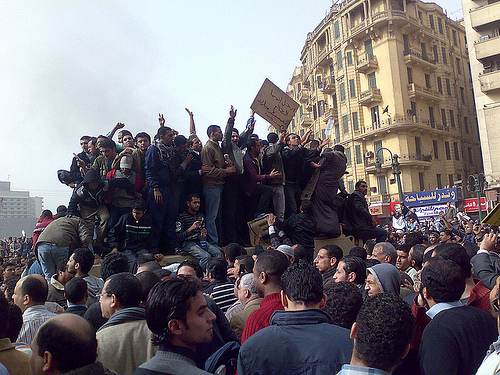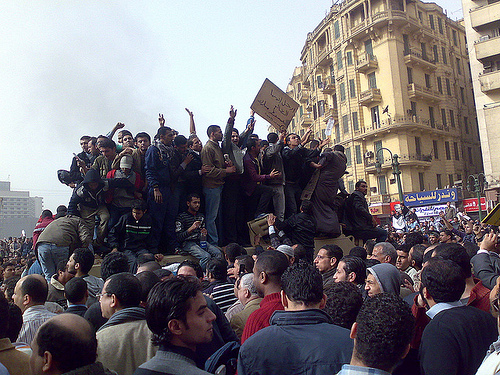 Protesters in the streets of Cairo.Photo: Ramy Raoof via WBURThere’s been a lot of debate in recent days over just how important a role social media like Facebook and Twitter have played in the recent popular uprisings in Tunisia and Egypt. Those discussions have become irrelevant. Because whether or not this revolution began on social media, it has flowered on the streets of Egypt’s great cities.
Protesters in the streets of Cairo.Photo: Ramy Raoof via WBURThere’s been a lot of debate in recent days over just how important a role social media like Facebook and Twitter have played in the recent popular uprisings in Tunisia and Egypt. Those discussions have become irrelevant. Because whether or not this revolution began on social media, it has flowered on the streets of Egypt’s great cities.
The government of Hosni Mubarak could shut down the internet. It could shut down cell phone service. It could force Al Jazeera, which has been providing superb coverage of the events in Egypt, to close its Cairo bureau. It could arrest journalists and seize their equipment.
But the streets of Cairo themselves have been the medium that has carried the message of the Egyptian people. So have the streets of Alexandria, Suez, and other Egyptian cities. And the government’s efforts to keep people off those streets have failed completely.
Throughout history, cities have been the epicenters of revolution. Governments have always known this, and certain elements of urban design reflect it. When Vienna tore down its ancient fortifications in 1857 — the walls that had been designed to keep alien intruders out — Emperor Franz Joseph I commissioned the magnificent Ringstrasse to replace them. Like the grand boulevards of Baron Haussmann’s Paris, the Ringstrasse was specifically designed to thwart potential popular uprisings. Too broad to be easily blocked by barricades, like the ones that were key to the European Revolutions of 1848, the Ringstrasse was also wide enough to accommodate the cannons that could be turned against a politicized proletariat. Baron Haussmann’s leafy avenues could give an army good clear sightlines for firing on rebels.
As the British Marxist historian Eric Hobsbawm points out in his fascinating essay “Cities and Revolutions,” the wider boulevards had another effect:
[T]he new and wide avenues provided an ideal location for what became an increasingly important aspect of popular movements, the mass demonstration, or rather procession. The more systematic these rings and cartwheels of boulevards, the more effectively isolated these were from the surrounding inhabited area, the easier it became to turn such assemblies into ritual marches rather than preliminaries to riot.
But then Hobsbawm goes on to say that a city’s design is not necessarily predictive of its potential to foster a revolution.
Revolutions arise out of political situations, not because some cities are structurally suited to insurrection. Still, an urban riot or spontaneous uprising may be the starter which sets the engine of revolution going. That starter is more likely to function in cities which encourage or facilitate insurrection.
Certain infrastructure factors can make cities more likely to serve as revolutionary centers. Hobsbawm notes that places where the ruling power is centrally located are especially vulnerable. In Cairo, the headquarters of Hosni Mubarak’s National Democratic Party — right in the heart of town — was gutted by fire early in the protests. That destruction made an unforgettable visual statement that reverberated around Egypt and the world.
The ability of the protesters to take control of other key pieces of Cairo’s infrastructure and public space has been crucial to the movement in the past few days. The movement of protesters from mosques on the west side of the Nile over the Kasr-al-Nil Bridge was one of the uprising’s defining moments so far.
And the continuous occupation of Tahrir Square by the anti-Mubarak forces since Jan. 25 has been perhaps the most powerful symbolic manifestation of the rebellion. This is the city’s central public space (designed in the 19th century, incidentally, as part of an effort to make Cairo more like Paris). Now it has become a focal point for those who are agitating for change — and an amazingly fertile meeting place for people of all classes and backgrounds. According to a citizen audio report filed on Jan25voices from Tahrir Square earlier today, people are composing protest songs together on the spot.
Much will be made in the days and weeks to come of the role played by social media in the Jan. 25 movement, no matter what the final outcome. But even El Shaheeed, the pseudonymous creator of a Facebook page memorializing a victim of police brutality that has served as a catalyst in the protests, said in an interview with The Daily Beast that virtual activism could not result in real change:
El Shaheeed also cautioned against investing too much power in social-media tools — online calls to protests had fallen flat in the past, and, at the end of the day, people would have to leave the screens for the streets. With that in mind, El Shaheeed stressed interaction with fans of the Facebook page — constantly polling, corresponding, and asking for advice, and posting downloadable fliers that could be passed out in person. “My role is to motivate people, inform them, encourage them to be part of the event and not just report it,” said El Shaheeed, hoping that if enough people got into the streets, the movement would become unstoppable.
This story is a long way from being over. It will play out in the streets and squares of Cairo, Alexandria, and Suez.
As I write these words, the number of people defying curfew to join the crowd in Tahrir Square is growing. According to another citizen audio report from Jan25voices, there is a new chant among the people there. Roughly translated: “Whoever is sitting on the couch watching the television feels anxious and paranoid. Whoever is in the street feels secure.”


